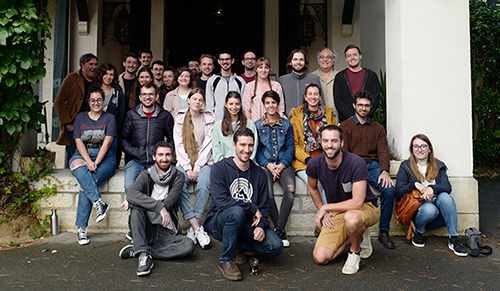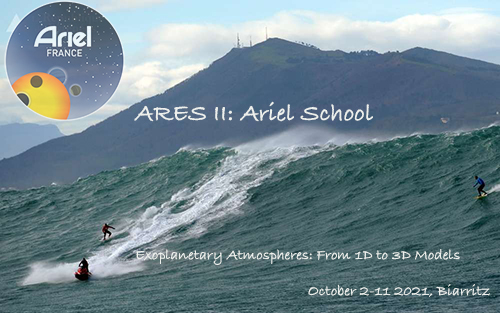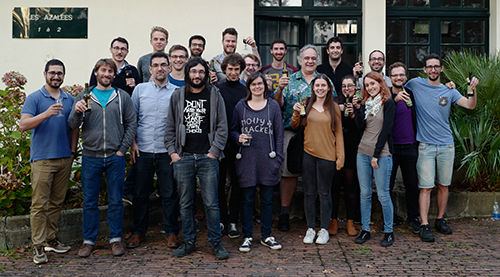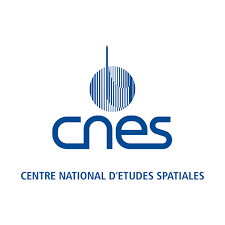|
ARES II: ARIEL School, biarritz 2021
Dates : 2 – 11 October 2021 Organisers: Jean- Philippe Beaulieu, Pierre Drossart Quentin Changeat, Jeremy Leconte, Angelos Tsiaras, Olivia Venot, Ingo Waldmann. Tutors : Yassin Jaziri, Ahmed Al-Refaie, Aurelien Falco Sponsor: CNES, CNRS |
 ARIEL-SCHOOL-2021.JPG ARIEL-SCHOOL-2021.JPG
The 2021 ARES Class.
The 2019 ARES class. The 1st Ariel school in Biarritz was held in September 2019 and devoted to atmospheric retrieval studies through open source codes. It has been a great success and resulted in five academic papers published to date. These were leaded by participating students and based on work begun during the school and continued thereafter. Location :The first two Ariel school took place at the Village de vacances VTF "Le domaine de Françon", 81 Rue de Salon, 64200 Biarritz, France. Biarritz is bordered by the Atlantic Ocean and crossed by the Pyrenees mountain range. Nestled in the extreme south-west of France, Biarritz is an elegant city, acclaimed for its beaches, surf spots, golf courses, thalassotherapy centers and gastronomy. Useful links from the 2019 edition Chemical equilibrium calculation Iraclis pipeline (analysis HST data)
Presentation ARIEL en français (2019)
|
Ariel is a space telescope project that will measure the composition and structure of the atmospheres of 1000 extrasolar planets, from gas giants to hot and temperate rocky planets, around stars of different types. It will constrain the nature of the planets, detect the presence of clouds and study the interactions of these other worlds with their host stars. ARIEL is supported by a consortium of more than 60 institutes in 15 European countries, under British coordination, and two major partners, France (IAP, CEA, LESIA and IAS) and Italy. The project was selected in 2018 by the European Space Agency (ESA) as the fourth Mid-class mission which will launch ARIEL in 2028 from Kourou, Guyana. In preparation of the science preparation and exploitation, we are organizing regularly an ARIEL school. This is the second edition. This school will address the central question in exoplanetary retrieval of the accuracy of the modeling. As spectroscopic observations are slowly improving from simple composition retrieval towards more accurate atmospheric structure modeling, one-dimensional models in chemistry and cloud structure, or 2D models in global circulation may reach their limits. This school will be organized starting with curses giving a background on exoplanetary atmospheres, radiative transfer questions and chemical or meteorological models, followed by training session with direct involvement in retrieval and simulation with up-to-date models. Hands-on work is an important component of the school.
Exoplanetary atmospheres : from 1D to 3D models Objectives : to achieve a good synthesis of the questions related to 1D-3D modeling of planet atmospheres with application to selected systems and new deeper study of 1-3 systems. We will perform blind test work, trying to retrieve the underlying systems of realistic simulated observations. By-products : write a unique master paper including all the results reached during the school. Structure : courses + training session (with one or more senior, two juniors working together) Program (click here) L1 : Detection of exoplanets :methods, spectral observations (Jean-Philippe Beaulieu) L2 : Atmospheric structure, thermal structure, Radiative –convective models (Pierre Drossart) L2bis : Atmospheric structure (Quentin Changeat) L3 : Thermochemistry and Photochemistry (Olivia Venot) L4 : Atmospheric dynamics – theory (Jeremy Leconte) S1 : Molecular spectroscopy (Olivia Venot) S2 :Global Circulation models (Jeremy Leconte) Einstein 1926 article about tea leaves in a rotating pot S3: Relations between Solar System and exoplanets (Pierre Drossart) S4 : Clouds, condensation, haze,microphysics (Pierre drossart) S5 : Spectral reduction (Angelos Tsiaras) L5 : Optimization methods, Bayesian methods (Ingo Waldmann) L = long course (2h * 6) S= short course (1h * 5) + introduction to training 1h The tutorial are described at the end of Jeremy Leconte's talk (see link above, or here) and by Quentin Changeat here. Further readings about the school
Organisation of training sessions with independent groups working in parallel in competition : • 1st part – Each group creates 3 models with GCM (3D) and chemistry (1D) – TBD • 2d part – Each group must make retrievals from the output of the other group and find out what were the underlying initial models. Conclusions and future plans = 2h (Saturday Oct 9) – plan of future master paper The school is open to PhD students and post-doctoral researchers, with a total headcount of 20 participants. Teaching will be presented by researchers and professors of the field, with training session supported by young research scientists involved in the development of the models.
|


